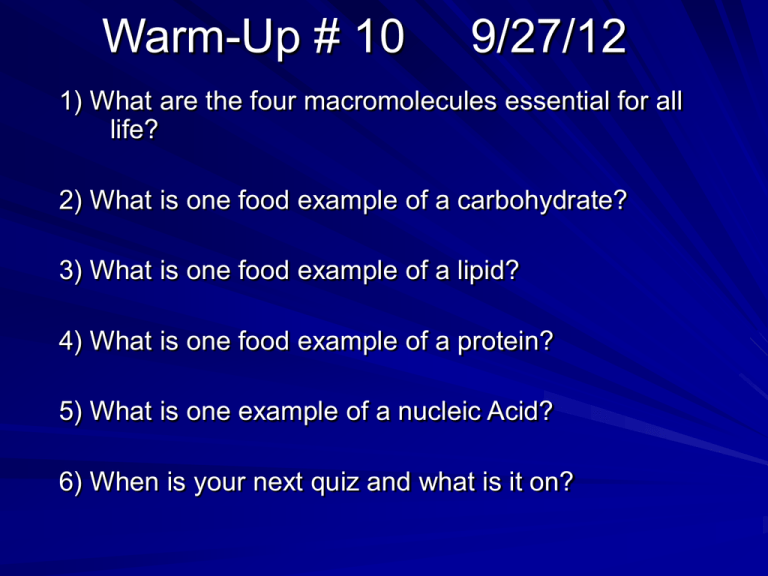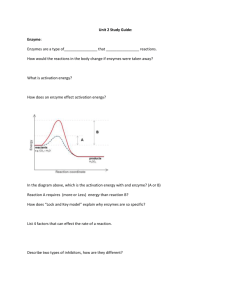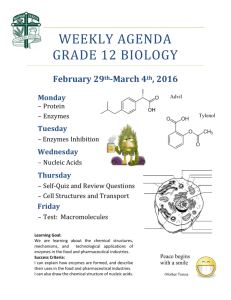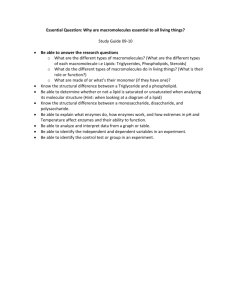Macromolecules, Chemical Reactions & Enzymes
advertisement

Warm-Up # 10 9/27/12 1) What are the four macromolecules essential for all life? 2) What is one food example of a carbohydrate? 3) What is one food example of a lipid? 4) What is one food example of a protein? 5) What is one example of a nucleic Acid? 6) When is your next quiz and what is it on? Warm-Up # 9 9/26/12 QUIZ TODAY 1) Water sticking to water is called____. 2) Some insects can stand on water because water has a high _________. 3) label the water molecule with O, H, +, and – 4) Match the pH scale with the following word: Neutral, Strong Acid, Strong Base, Weak Acid, Weak Base Macromolecules Unit 2 Biochemistry What Will We Learn Today? EQ: What molecules make up all living things? Objective: differentiate between the four types of molecules. Organic Chemistry Carbon – most versatile element – bonds with many different elements (H, O, S, N, P, C) – forms large and complex structures. Macromolecules Means giant molecules Small units called monomers join to form large units called polymers which are the same as macromolecules There are 4 groups – Carbohydrates – Lipids – Nucleic acids – Proteins Macromolecules Name Carbohydrates Lipids Nucleic Acids Proteins Examples Function Main Structure elements Carbohydrates Examples Function Sugars Glucose Energy (MONOSACCHARIDE) Cellulose Fructose Lactose Starch-stored form of sugar (POLYSACCHARIDE) Main Structure Elements C H Structure— O cell walls Monomer= single sugar Polymer= starch glucose glucose Glycogen or starch Lipids Examples Function Main Structure Elements Fats Oils Waxes *not water soluble Stored energy C H O Structure— cell membrane Protective coverings Saturated/ Unsaturated Fats Glycerol + 2 or 3 Fatty acid chains Lipid: Glycerol + 2 or 3 Fatty Acids •Di-glycerides are mostly plant oils & waxes •Tri-glycerides are mostly animal fats Fatty Acids = Carbon Chains Nucleic Acids Examples Function Main Structure Elements DNA RNA Carries hereditary information C H O P N Monomer = nucleotides Polymer = DNA or RNA nucleotide Proteins Examples Function Main Structure Elements Enzymes Control reaction rate Form structures Transport substances Fight diseases C H O N S Lactase Catalase Antibodies Insulin Hemoglobin Monomer = Amino Acids Polymer = Proteins Macromolecule Activity •With your clock buddy, you will: –Cut all word and pictures from the handouts –Glue words and pictures on to construction paper –Organize them into Carbs, Proteins, Lipids, Nucleic Acids –You will do two macromolecules and your partner will do the other two –Label everything you can –Use your notes from today Warm-Up #12 10/1/12 1) When is your next quiz? Test? 2) What is the monomer of a protein? 3) What is the monomer of a nucleic acid? 4) What sugar is found in plant cell walls? EQ: What affect does enzymes have on a reaction? Chemical Reactions Changes one set of chemicals into another set of chemicals Require energy Reactants IN Products OUT Chemical bonds are ALWAYS broken and new bonds are formed 2H2 + O2 2H2O Energy in Reactions Energy-Absorbing Reaction Energy-Absorbing Reaction Energy-Releasing Reaction Energy-Releasing Reaction Activation Activation energy energy Products Products Activation energy Activation energy Reactants Reactants Some reactions absorb energy Reactants Reactants Products Products Some reactions release energy Energy in Reactions Energy can be released as heat, light, or sound. Living organisms need energy source to carry out chemical reactions. Some reactions need activation energy to get started. (activation energy) Enzymes A catalyst speeds up the rate of a chemical reaction. An enzyme is a catalyst for a biological chemical reaction—inside cells! Enzymes are very specific—one enzyme for one chemical reaction. Enzymes Substrates (reactants) attach to the active site of a specific enzyme. (enzymesubstrate complex When the enzyme-substrate complex is formed, the enzyme converts the substrate into products. The products are released. The enzyme can carry out another reaction. Enzyme (hexokinase) Glucose Substrates Products ADP Glucose-6phosphate Products are released ATP Active site Enzyme-substrate complex Substrates are converted into products Substrates bind to enzyme Enzymes Work best at certain pH and temperature levels. Enzymes in humans work best at 37°C, normal body temperature.






